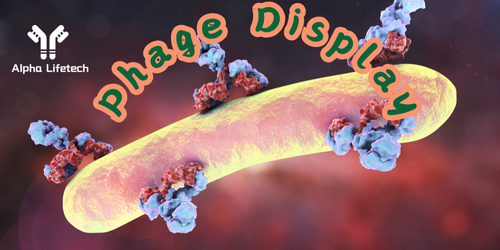Title: High-Throughput Discovery of SARS-CoV-2 Neutralizing VHH Antibodies Using Phage Display
Introduction
The COVID-19 pandemic, caused by the SARS-CoV-2 virus, has driven an urgent need for effective therapeutics, particularly neutralizing antibodies. While conventional monoclonal antibodies (mAbs) have shown promise, single-domain antibodies (VHHs), derived from camelid heavy-chain-only antibodies, offer unique advantages such as small size (~15 kDa), high stability, strong binding affinity, and ease of production. Phage display, a high-throughput screening technology, has been extensively used for isolating potent neutralizing VHH antibodies against SARS-CoV-2. This analysis explores the methodology, advantages, challenges, and therapeutic potential of using phage display to identify SARS-CoV-2 neutralizing VHH antibodies.
Phage Display for High-Throughput VHH Antibody Discovery
Phage display technology enables the rapid screening and isolation of VHH antibodies against viral antigens. By constructing a diverse VHH library and subjecting it to iterative selection against SARS-CoV-2 spike protein, researchers can identify high-affinity neutralizing antibodies.
Library Construction
The success of phage display screening depends on a diverse and high-quality VHH library, which is typically generated from:
- Immunized Camelids (e.g., alpacas or llamas) – B cells from animals immunized with the SARS-CoV-2 spike protein or receptor-binding domain (RBD) are harvested.
- Synthetic or Naïve Libraries – Created through in vitro mutagenesis or combinatorial approaches to maximize sequence diversity.
The VHH genes are amplified using RT-PCR, cloned into M13 bacteriophage vectors, and displayed on the phage coat protein (pIII) for screening.
Biopanning Against SARS-CoV-2 Antigens
Phage-displayed VHH libraries undergo multiple rounds of biopanning to enrich for high-affinity binders. The selection process includes:
- Incubation with SARS-CoV-2 Spike Protein (Full-length or RBD) – Phages expressing VHHs that bind to the target antigen are retained.
- Washing to Remove Weak Binders – Stringency is increased in each round to isolate the strongest binders.
- Elution and Amplification – Bound phages are eluted, amplified in E. coli, and subjected to additional rounds of selection.
- High-Throughput Screening (HTS) and Next-Generation Sequencing (NGS) – Identifies enriched VHH clones with optimal binding properties.
After 3–4 rounds of selection, the best-performing VHH antibodies are characterized for neutralization potency.
Characterization of SARS-CoV-2 Neutralizing VHH Antibodies
The lead VHH candidates are extensively characterized for binding affinity, specificity, and neutralization efficiency.
Binding Affinity and Specificity
- Surface Plasmon Resonance (SPR) or Bio-Layer Interferometry (BLI) – Measures real-time binding kinetics (association/dissociation rates, KD values).
- Enzyme-Linked Immunosorbent Assay (ELISA) – Confirms specific interaction with the SARS-CoV-2 spike protein.
- Epitope Mapping – Identifies whether VHHs bind to the RBD, N-terminal domain (NTD), or other critical regions of the spike protein.
SARS-CoV-2 Neutralization Assays
- Pseudovirus Neutralization Assay – Evaluates VHH ability to block viral entry into ACE2-expressing cells.
- Live Virus Neutralization (Plaque Reduction Assay) – Tests VHH effectiveness against actual SARS-CoV-2 strains.
Structural Analysis
- Cryo-Electron Microscopy (Cryo-EM) or X-ray Crystallography – Determines how VHHs bind to the spike protein at atomic resolution.
- Computational Modeling – Predicts VHH-antigen interactions and informs affinity maturation strategies.
Advantages of VHH Antibodies for SARS-CoV-2 Therapy
Compared to conventional monoclonal antibodies, VHHs offer several key benefits for antiviral therapeutics:
- Small Size (15 kDa) – Allows deeper penetration into tissues (e.g., lung epithelium) and access to cryptic epitopes.
- High Stability – Resists extreme pH, temperature, and proteolytic degradation, making VHHs ideal for inhaled or oral delivery.
- High Affinity and Neutralization Potency – Engineered VHHs often exhibit picomolar binding affinity, effectively blocking viral entry.
- Cost-Effective Production – VHHs can be produced in microbial expression systems (e.g., E. coli, yeast), reducing manufacturing costs.
- Multivalent and Multispecific Formats – VHHs can be linked together to enhance neutralization, reduce viral escape, and increase half-life.
Engineering Strategies to Enhance VHH Therapeutic Potential
To maximize their clinical utility, VHH antibodies undergo further optimization and engineering:
Yeast Surface Display or Deep Mutational Scanning improves binding affinity.
Humanization of VHH Frameworks ensures reduced immunogenicity for therapeutic applications.
- Multivalent and Multispecific Formats
VHH-Fc Fusions (Camelid-human hybrid antibodies) extend serum half-life.
Biparatopic VHHs (targeting different spike regions) increase neutralization breadth.
Trimeric VHH Constructs enhance avidity and efficacy.
- Alternative Delivery Methods
Inhaled VHHs (Nebulization or Intranasal Delivery) provide direct pulmonary protection.
mRNA-Encoded VHH Therapeutics enable in vivo expression of neutralizing antibodies.
Challenges and Future Directions
- Viral Evolution and Escape Mutants
SARS-CoV-2 continuously evolves, with variants like Omicron exhibiting immune escape.
Solution: Broadly neutralizing VHH cocktails targeting conserved spike regions.
- Immune System Clearance and Stability in Vivo
Small VHHs have rapid renal clearance.
Solution: PEGylation or Fc fusion extends half-life.
- Large-Scale Manufacturing and Regulatory Hurdles
Optimized expression platforms (e.g., CHO, yeast, or bacterial systems) are required for scalable production.
Future Prospects
AI-Driven VHH Discovery – Predicting high-affinity VHHs using machine learning.
Universal Coronavirus Therapeutics – Targeting conserved sarbecovirus epitopes.
CRISPR-Based VHH Gene Therapy – In vivo expression of antiviral VHHs.
Conclusion
Phage display technology enables the high-throughput discovery of SARS-CoV-2 neutralizing VHH antibodies, offering a promising avenue for low-cost, scalable, and highly effective therapeutics. The combination of affinity maturation, structural optimization, and innovative delivery strategies enhances the clinical potential of VHHs in combating SARS-CoV-2 and emerging variants. Future developments in AI-driven design, multi-specific antibody formats, and gene therapy approaches will further expand the application of VHH-based therapeutics in infectious diseases.






Comments